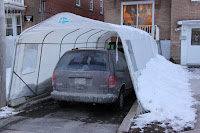According to the locals, it’s a mild winter in Quebec this year. In the ten days since we’ve been here, it’s averaged a mere -5C. On the streets, people can be seen strolling around gloveless and hatless, as if they’re finding the current climate a bit balmy. To boot, it’s not even snowed in over 3 weeks!
 Nonetheless, snow is everywhere – and it’s a major part of everyday life. Our flat lease has a special clause about snow clearance: the driveway, stairway and entrance are the responsibility of the owner, while it’s up to us to shift snow from the balcony. The local council, meanwhile, has an annual budget of some $50 million to clear snow from the roads and pavements. Its fleet of snow-clearing equipment comprises 160 road snowploughs, 210 pavement snowploughs and 110 snow blowers. And every year, these machines jointly clear away an average of 7,500,000m3 of snow. (All these stats were gleaned from a recent visit to the informative if somewhat randomly-organised McCord Museum of Canadian History.)
Nonetheless, snow is everywhere – and it’s a major part of everyday life. Our flat lease has a special clause about snow clearance: the driveway, stairway and entrance are the responsibility of the owner, while it’s up to us to shift snow from the balcony. The local council, meanwhile, has an annual budget of some $50 million to clear snow from the roads and pavements. Its fleet of snow-clearing equipment comprises 160 road snowploughs, 210 pavement snowploughs and 110 snow blowers. And every year, these machines jointly clear away an average of 7,500,000m3 of snow. (All these stats were gleaned from a recent visit to the informative if somewhat randomly-organised McCord Museum of Canadian History.)  Unsurprisingly, the Quebecois have learned to embrace the snow. The winters here last six months – and that’s a very long period indeed to ‘just try and get through’. A weekend trip to the Parc Mont-Royal – Montreal’s biggest green (or rather white) space – showed us just how Montrealers make the most of their severe climate. In the park, you can ice-skate on the lake, toboggan on specially crafted tracks, snowshoe and cross-country ski in the woods, or even take a ride on a horse-drawn sleigh. What’s more, parents here don’t push their children in prams; they use mini-sledges to pull their kids along.
Unsurprisingly, the Quebecois have learned to embrace the snow. The winters here last six months – and that’s a very long period indeed to ‘just try and get through’. A weekend trip to the Parc Mont-Royal – Montreal’s biggest green (or rather white) space – showed us just how Montrealers make the most of their severe climate. In the park, you can ice-skate on the lake, toboggan on specially crafted tracks, snowshoe and cross-country ski in the woods, or even take a ride on a horse-drawn sleigh. What’s more, parents here don’t push their children in prams; they use mini-sledges to pull their kids along.

Intriguingly, though, there’s a complete lack of snowmen and snowball fights. I guess such activities lose their appeal when your hands freeze on contact with the snow.
Ice hockey here is the equivalent of football in most other parts of the world. Indeed, table football here has a distinctly different look.
 Canadian kids don’t dream of being Ronaldo or Messi; they want to be hockey heroes (can’t actually name any just yet, but give me a few months...). You see them clinging onto hockey sticks on the buses, wearing the attire of the local team (the Montreal Canadiens), and practicing their skills on the local ice rink after school. Just about every park or sports field has a free, open-air ice rink, and many rinks are refrigerated for use in the summer. No wonder the Canadians are so confident of Olympic hockey glory in Vancouver this year.
Canadian kids don’t dream of being Ronaldo or Messi; they want to be hockey heroes (can’t actually name any just yet, but give me a few months...). You see them clinging onto hockey sticks on the buses, wearing the attire of the local team (the Montreal Canadiens), and practicing their skills on the local ice rink after school. Just about every park or sports field has a free, open-air ice rink, and many rinks are refrigerated for use in the summer. No wonder the Canadians are so confident of Olympic hockey glory in Vancouver this year.
 I’ve also noticed what might be termed ‘car tents’ outside houses. Presumably, these temporary garages are designed to protect vehicles parked in the driveway from snowfall.
I’ve also noticed what might be termed ‘car tents’ outside houses. Presumably, these temporary garages are designed to protect vehicles parked in the driveway from snowfall.
One road I passed looked like a veritable camp site for cars.

In the city centre, you can shelter from the cold by using the RESO, a sprawling network of underground and overground tunnels that allows Montrealers to completely avoid contact with the outside world. This indoor city is the largest underground complex in the world, although I was rather disappointed to discover that it’s basically a very large shopping mall. Almost every square inch of the walkways is lined with shops, coffee houses and eateries.
There’s still at least another two months of winter to go, and I’m just hoping we don’t experience anything significantly colder than now. Even though I’m intrigued to know what -30C would feel like, we’re not yet equipped for it. And it’s proving distinctly tricky to buy decent Canadian winter-proof clothing. Most of the shops are already stocking their spring collections, despite the fact that the mercury is unlikely to rise above zero for a while yet. For the sake of winter sports, let it snow - but let it not get too much colder!

